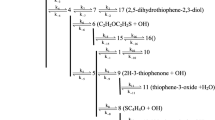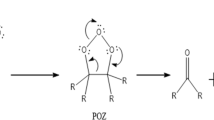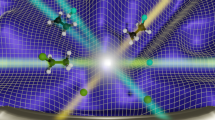Abstract
IN an earlier communication1 we made use of the appearance potentials of the fluorobenzene ions from some trifluoromethyl benzenes to obtain an estimate of the heat of formation of the difluoromethylene radical eliminated in these electron impact processes. This work gave values of about − 20 kcal mol−1 as the upper (most positive) limits for the heat of formation of the radical, compared with estimates of about −35 kcal mol−1 given by other workers2,3. If the latter estimates are the more correct, it would seem that the difluoromethylene radicals are eliminated in these impact processes with excess energy. Such behaviour is not unlikely in view of the demonstration that carbon monoxide is eliminated from benzalde-hyde by an electron impact process that involves excess energy (of about 3 eV)3. In an attempt to discover more about the thermochemistry of this radical, an investigation has been made of the appearance potentials of the difluoromethylene and ethylene ions. The measured appearance potentials (A.P.) and the derived apparent heats of formation of the ions, calculated using equations of the form: ΔHf(CX2+) = A(CX2+) − ΔHf(fragment) + ΔHf(molecule) are given in Table 1. The apparent heats of formation derived from the methanes were calculated on the assumption that the other products of the impact processes were diatomic molecules. The other products of the impact processes involving ethylenes were assumed to be methylene radicals. If the impact processes involving the methanes had been assumed to produce atoms as the other fragments, then much smaller values of the apparent heats of formation would have resulted. In particular, the values for CF2+ and CH2+ would be about 160 kcal mol−1 and 245 kcal mol−1 from CF2HCl and CH3Cl, respectively. The assumption that these are the values associated with the minimum of excess energy would lead to greater thermochemical inconsistencies than do those we have chosen. The lowest values for the apparent heats of formation of the methylene ion are those derived from the methanes and are represented by the value 339 ± 2 kcal mol−1. Although it is uncertain that this value includes no excess energy, we can be sure that the larger value found for the case of ethylene does include about 30 kcal or more excess energy. The value derived from CH2=CF2 will contain as little excess energy as the minimum derived from the methanes if the heat of formation of the difluoromethylene radical is –20 kcal mol−1, but more if the heat of formation of this radicalis more negative, as is favoured by some workers. The spectroscopic value of the ionization potential of methylene is 10.35 eV (ref. 7). It follows from this and the heat of formation of the ion that the heat of formation of the methylene radical is equal to or less than 100 kcal mol−1. This limit includes all the proposed values4.
This is a preview of subscription content, access via your institution
Access options
Subscribe to this journal
Receive 51 print issues and online access
$199.00 per year
only $3.90 per issue
Buy this article
- Purchase on Springer Link
- Instant access to full article PDF
Prices may be subject to local taxes which are calculated during checkout
Similar content being viewed by others
References
Majer, J. R., and Patrick, C. R., Nature, 192, 866 (1961).
Margrave, J. L., Nature, 197, 376 (1962), and earlier papers.
Majer, J. R., and Patrick, C. R., Trans. Farad. Soc., 59, 1274 (1963).
Cottrell, J. L., The Strengths of Chemical Bonds, second ed. (Butterworths, London, 1958).
Reed, R. I., and Snedden, W., Trans. Farad. Soc., 54, 301 (1958).
Margrave, J. L., J. Chem. Phys., 31, 1432 (1959).
Patrick, C. R., Advances in Fluorine Chemistry, 2, 1 (Butterworths, London, 1961).
Nat. Bur. Stand. Circ. 500 (1951).
Wicke, E., Angew. Chem., 60, 65 (1948).
Reed, R. I., and Snedden, W., Trans. Farad. Soc., 55, 876 (1959).
Lifshitz, L., and Long, F. A., paper presented before A. S. T. M. Comm. on Mass Spectrometry, New Orleans, June 1961 (private communication).
Majer, J. R., Patrick, C. R., and Robb, J. C., Trans. Farad. Soc., 57, 14 (1961).
Warren, J. W., and Craggs, J. D., Mass Spectrometry, 36 (Institute of Petroleum, 1952).
Price, W. C., Bralsford, R., and Roessler, D. M., Spectroscopy, edit. by Wells, M. J., 279 (Institute of Petroleum, London, 1962).
Author information
Authors and Affiliations
Rights and permissions
About this article
Cite this article
MAJER, J., PATRICK, C. Appearance Potentials and Apparent Heats of Formation of the Methylene and Difluoromethylene Ions. Nature 201, 1022–1023 (1964). https://doi.org/10.1038/2011022a0
Issue Date:
DOI: https://doi.org/10.1038/2011022a0
This article is cited by
Comments
By submitting a comment you agree to abide by our Terms and Community Guidelines. If you find something abusive or that does not comply with our terms or guidelines please flag it as inappropriate.



